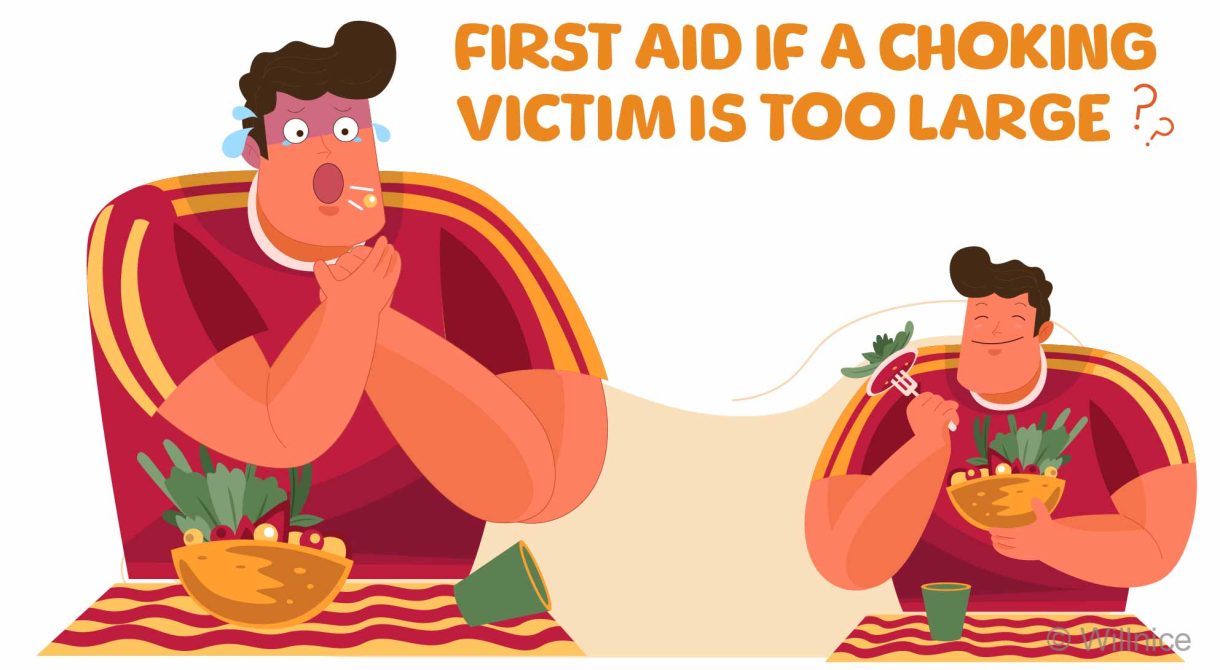
Choking is a sudden, life-threatening emergency that can happen to anyone, anywhere. When an airway is blocked, even partially, every second counts, knowing what to do—and doing it quickly—can mean the difference between life and death.
What’s more, the challenge of helping someone in distress can vary depending on their size. Larger individuals, for example, may require different approaches to clear the airway and restore breathing effectively. This makes it essential to understand techniques that work for people of all body types.
In this guide, we’ll walk you through a detailed, step-by-step process to handle choking emergencies with confidence. Whether it’s assisting a family member, a colleague, or even a stranger, you’ll learn actions that can save lives—especially when the person in need requires tailored support due to their size.
Understanding Choking
Choking is an emergency that requires immediate attention and action. By understanding what choking entails, its causes, and its symptoms, you can be better prepared to save lives.
What Is Choking?
Choking occurs when the airway becomes partially or fully obstructed, preventing proper airflow to the lungs. This obstruction can arise when a piece of food, a small object, or another foreign item blocks the throat or windpipe. Without oxygen, the brain and other vital organs are at risk, making swift action critical.
The causes of choking often involve situations where objects accidentally enter the airway instead of the digestive tract. For example, swallowing food too quickly or laughing while eating can easily lead to a blockage. While choking can happen to anyone, certain factors—like medical conditions or impaired swallowing—can increase the risk.
Common Causes of Choking
Choking has several common triggers. Recognizing these can help in preventing such emergencies:
- Eating Too Quickly or Large Food Pieces
Not chewing food properly or rushing meals can cause large pieces to become lodged in the throat. Foods like steak, bread, and hard candies are particularly problematic.
- Small Objects and Toys
Children are particularly vulnerable to choking on small household items, such as buttons, coins, or toy parts, which can easily fit into their mouths and block their airways.
- Medical Conditions Like Dysphagia
Dysphagia, a condition characterized by difficulty swallowing, often makes it challenging to eat or drink safely. It’s especially common in older adults or those with neurological conditions.
- Alcohol or Drug Use Impairs Swallowing
Alcohol or drug consumption can slow reflexes and impair coordination, making it easier for food or objects to enter the airway instead of the esophagus.
Symptoms of Choking
Recognizing the signs of choking can help you respond quickly and effectively. Some common symptoms include:
- Difficulty Speaking or Breathing
A person who is choking may struggle to talk, cough weakly, or gasp for air. These are clear indicators that something is obstructing their airway.
- Skin Turning Blue or Dusky
When oxygen levels drop due to a blocked airway, the skin, particularly around the lips and fingertips, may develop a bluish or grayish hue.
- Universal Distress Signal
One of the most recognizable signs of choking is when a person instinctively grasps their throat with one or both hands. This is commonly referred to as the universal distress signal.
By understanding what choking is, identifying its causes, and knowing the symptoms, you are better equipped to react to and manage this life-threatening situation.
Here’s the content based on your prompts, crafted to be high-value, easy to read, and actionable:

First Aid for Choking Victims
Choking is a life-threatening emergency that requires immediate action. Knowing how to provide first aid can save lives. Below are clear, step-by-step instructions for assisting both conscious and unconscious choking victims.
1. For Conscious Victims
When a choking victim is conscious, quick intervention is critical to clear the airway.
Overview of the Heimlich Maneuver
The Heimlich maneuver, also known as abdominal thrusts, is the most common and effective method for dislodging an object that blocks the airway. It works by creating a sudden burst of pressure in the airway to expel the obstruction.
Step-by-Step Guide for Performing Abdominal Thrusts
- Stand behind the victim and wrap your arms around their waist.
- Make a fist with one hand and place the thumb side against the victim’s abdomen, just above the navel but below the ribcage.
- Grasp your fist with your other hand.
- Deliver quick, upward thrusts, pulling inward and upward simultaneously.
- Repeat until the object is expelled or the victim becomes unconscious.
Adjustments for Larger Individuals
- If the victim is too large for abdominal thrusts, use chest thrusts instead:
- Place your fist on the center of the victim’s chest, just above the sternum.
- Grasp your fist with your other hand and deliver quick, inward thrusts.
- For pregnant individuals, chest thrusts are also recommended to avoid pressure on the abdomen.
2. For Unconscious Victims
If the victim becomes unconscious, the situation becomes more critical. Immediate action and professional help are essential.
Importance of Calling Emergency Services Immediately
- Dial emergency services (e.g., 911) as soon as the victim becomes unresponsive.
- Stay on the line and follow the dispatcher’s instructions while providing first aid.
Step-by-Step CPR Instructions Tailored for Choking Victims
- Check for Responsiveness: Tap the victim and shout to see if they respond.
- Open the Airway: Tilt the head back and lift the chin to open the airway.
- Check for Breathing: Look, listen, and feel for breathing for no more than 10 seconds.
- Begin Chest Compressions:
- Place the heel of one hand on the center of the chest, with the other hand on top.
- Push hard and fast at a rate of 100-120 compressions per minute, allowing the chest to fully recoil between compressions.
- Check for Obstructions:
- After every 30 compressions, open the airway and look for visible obstructions.
- If you see an object, carefully remove it with your fingers. Avoid blind sweeps, as this can cause the object to move further down.
- Provide Rescue Breaths:
- If the airway is clear, give two rescue breaths by sealing your mouth over the victim’s and blowing air into their lungs.
- Continue cycles of 30 compressions and two breaths until help arrives or the victim starts breathing.
How to Check for and Remove Visible Obstructions
- If you can see the object blocking the airway, gently use your fingers to remove it.
- Be cautious not to push the object deeper into the throat.
By following these first aid steps, you can provide life-saving assistance to choking victims. Always prioritize calling for professional help while taking immediate action to clear the airway.
Special Considerations for Larger Individuals
When assisting larger individuals in emergencies, such as choking, it’s essential to adapt techniques to ensure effectiveness. Below are key considerations and methods to address these challenges.
1. Challenges in Assisting Larger Victims
Physical Limitations in Performing Abdominal Thrusts
For larger individuals, traditional abdominal thrusts (commonly known as the Heimlich maneuver) may be challenging to perform due to physical constraints, such as:
- Limited reach around the victim’s abdomen.
- Difficulty applying sufficient force to dislodge the obstruction.
Adjusting Techniques to Ensure Effectiveness
To overcome these challenges:
- Position yourself slightly to the side for better leverage.
- Use your dominant hand to apply more focused pressure.
- Consider alternative methods, such as chest thrusts, when abdominal thrusts are not feasible.
2. Chest Thrusts: A Viable Alternative
When abdominal thrusts are not practical or possible, chest thrusts can be a lifesaving alternative. Here’s how to perform them:
Step-by-Step Guide for Performing Chest Thrusts
- Stand behind the individual and place your arms under their armpits.
- Make a fist with one hand and place the thumb side against the center of their chest, just above the sternum.
- Grasp your fist with your other hand.
- Deliver quick, inward and upward thrusts, aiming to create enough pressure to expel the obstruction.
When and How to Use This Method
- Use chest thrusts if the individual is pregnant, obese, or if abdominal thrusts are not effective.
- Ensure the individual is leaning slightly forward to allow the object to exit the airway.
3. Using Available Tools or Assistance
In some cases, tools or additional support may be necessary to assist individuals with larger physical needs effectively.
Leveraging Chairs or Sturdy Objects for Self-Heimlich
If the individual is alone or rescuers are unable to perform thrusts:
- Find a sturdy object, such as the back of a chair or a countertop.
- Position the object just above the navel.
- Lean forward forcefully against the object to create pressure and dislodge the obstruction.
Involving Multiple Rescuers if Necessary
- If one rescuer cannot perform the maneuver effectively, involve others to assist.
- One person can stabilize the victim while another performs the thrusts.
- Communication and coordination are key to ensuring the victim’s safety.
By understanding these special considerations and adapting techniques, rescuers can provide practical assistance to larger individuals in critical situations. Always prioritize safety and seek professional medical help if the obstruction cannot be cleared.
Choking Prevention Tips
Choking is a preventable emergency, and taking proactive steps can significantly reduce the risk. Below are practical tips tailored for high-risk groups, home environments, and public settings.
1. For High-Risk Groups
Specific individuals are more vulnerable to choking, and extra precautions should be taken to protect them.
Elderly Individuals and Children
- Elderly: Age-related changes, such as reduced muscle strength and slower reflexes, increase the risk of choking. Dentures and dry mouth can also make swallowing more difficult.
- Children: Young children are naturally curious and may put small objects or large pieces of food in their mouths, leading to choking hazards.
People with Medical Conditions Affecting Swallowing
- Conditions such as Parkinson’s disease, stroke, or neurological disorders can impair swallowing.
- Individuals with these conditions should eat slowly, avoid distractions during meals, and consult a healthcare provider for tailored dietary recommendations.
2. At Home
The home is where many choking incidents occur, but simple measures can make a big difference.
Cutting Food into Smaller Pieces
- For both children and adults, cutting food into bite-sized pieces can reduce the risk of choking.
- Avoid serving high-risk foods like whole grapes, hard candies, or large chunks of meat without proper preparation.
Supervising Children During Meals
- Always supervise young children while they eat to ensure they chew thoroughly and don’t rush their meals.
- Teach children to sit down while eating and avoid talking or laughing with food in their mouths.
3. In Public Settings
Public spaces like restaurants and schools can also be high-risk areas for choking. Preventative measures here are crucial.
Training Staff in Restaurants and Schools
- Restaurant staff should be trained to recognize signs of choking and perform first aid, such as abdominal thrusts.
- School staff, especially those working with young children, should be equipped to handle choking emergencies.
Importance of Accessible First-Aid Training
- First-aid training, including choking response techniques, should be widely available and encouraged for the general public.
- Having accessible first-aid kits and posters with choking response instructions in public spaces can save lives.
By implementing these choking prevention tips, we can create safer environments for everyone, particularly those who are most at risk. Prevention is always the best approach, but knowing how to respond in an emergency is equally essential.
FAQs: First Aid for Choking
Choking emergencies can be stressful, but knowing the answers to common questions can help you act quickly and confidently. Here are some frequently asked questions about choking first aid.
1. Can the Heimlich Maneuver Be Performed on Oneself?
Yes, it is possible to perform the Heimlich maneuver on yourself. If you are alone and choking, follow these steps to dislodge the obstruction:
Step-by-Step Guide for Self-Heimlich
- Make a fist with one hand and place the thumb side against your abdomen, just above the navel but below the ribcage.
- Grasp your fist with your other hand.
- Perform quick, upward thrusts into your abdomen using your hands.
- If this doesn’t work, find a sturdy object, such as the back of a chair or a countertop.
- Lean over the object, positioning it just above your navel, and press your abdomen forcefully against it.
- Repeat this process until the object is expelled or you can breathe normally again.
Tip: Always seek medical attention after a choking incident, even if you successfully clear the obstruction.
2. What Should You Do If the Victim Becomes Unconscious?
If the victim becomes unconscious while choking, it’s critical to transition from the Heimlich maneuver to CPR immediately. Here’s what to do:
Transitioning from Heimlich to CPR
- Call Emergency Services: Dial 911 or your local emergency number immediately.
- Lay the Victim Flat: Gently lower the victim to the ground on their back.
- Begin Chest Compressions:
- Place the heel of one hand on the center of the chest, with the other hand on top.
- Push hard and fast, at a rate of 100-120 compressions per minute.
- Check for Obstructions:
- After every 30 compressions, open the airway by tilting the head back and lifting the chin.
- Look for visible obstructions in the mouth and remove them carefully if present.
- Provide Rescue Breaths:
- If the airway is clear, give two rescue breaths by sealing your mouth over the victim’s and blowing air into their lungs.
- Continue cycles of 30 compressions and two breaths until help arrives or the victim starts breathing.
Note: If you’re not trained in CPR, focus on chest compressions until professional help arrives.
3. When Should You Stop Performing First Aid?
Knowing when to stop first aid is just as important as knowing how to perform it. Here are the key signs to look for:
Signs of Recovery
- The victim expels the object and resumes normal breathing.
- The victim regains consciousness and is able to speak or cough.
When Professional Help Takes Over
- Stop performing first aid when emergency medical personnel arrive and take over the situation.
- Please provide them with any relevant details about the incident, such as how long the victim was choking and what actions you took.
Important Reminder: If the victim recovers, they should still seek medical attention to ensure there are no complications, such as damage to the airway.
By understanding these FAQs, you’ll be better prepared to handle choking emergencies effectively and confidently. Remember, quick action can save lives!
Advanced Training and Resources
Being prepared for emergencies can make the difference between life and death. Advanced training and the right tools empower individuals to respond effectively in critical situations. Here’s what you need to know about first aid training and emergency preparedness.
1. Importance of First Aid and CPR Certification
How Training Can Save Lives
First aid and CPR certification equips individuals with the knowledge and skills to act quickly and confidently during emergencies. Whether it’s performing the Heimlich maneuver, administering CPR, or using an AED, trained responders can:
- Prevent minor injuries from escalating.
- Provide life-saving care before professional help arrives.
- Reduce recovery time and improve outcomes for victims.
Overview of Available Courses and Certifications
- American Red Cross: Offers comprehensive first aid, CPR, and AED training for individuals and workplaces.
- American Heart Association (AHA): Provides Basic Life Support (BLS) and Heartsaver courses tailored for healthcare professionals and the general public.
- Online and Blended Learning Options: Many organizations now offer hybrid courses that combine online learning with in-person practice sessions.
- Specialized Training: Look for courses that include choking response techniques, pediatric first aid, and advanced resuscitation methods.
Tip: Certifications typically need to be renewed every 1-2 years to ensure skills remain up-to-date.
2. Recommended Tools for Emergency Preparedness
Having the right tools on hand can significantly improve your ability to respond to emergencies. Here are some essential items to consider:
FDA-Approved AEDs and Their Role in Emergencies
- What is an AED? An Automated External Defibrillator (AED) is a portable device that delivers an electric shock to help restart a heart in cardiac arrest.
- Why It’s Important: Cardiac arrest can happen suddenly, and using an AED within the first few minutes can double or triple survival rates.
- Recommended Models: Look for FDA-approved AEDs that are easy to use, come with clear instructions, and include pediatric pads for children.
- Where to Keep Them: AEDs should be accessible in public spaces, workplaces, schools, and homes with high-risk individuals.
First-Aid Kits and Choking Response Tools
- First-Aid Kits: A well-stocked kit should include bandages, antiseptics, gloves, scissors, and a CPR mask. Consider adding items like burn dressings and splints for more comprehensive care.
- Choking Response Tools: Devices like LifeVac or Dechoker are designed to help clear airway obstructions quickly and effectively. These tools can be handy for individuals who may not have the strength to perform abdominal thrusts.
Tip: Regularly check and replenish your emergency supplies to ensure they are ready for use when needed.
By investing in advanced training and equipping yourself with the right tools, you can be prepared to handle emergencies with confidence. Remember, preparation is the key to saving lives!
Boosting Your Preparedness
Emergencies like choking can happen anywhere and to anyone. Being prepared boosts your confidence and ability to act effectively. Take these steps to improve your readiness:
- Enroll in a basic first-aid or CPR certification course.
- Educate your family and community about choking prevention and first-aid techniques.
- Keep emergency numbers easily accessible.
- Create a printable first-aid reference guide for your home or workplace.
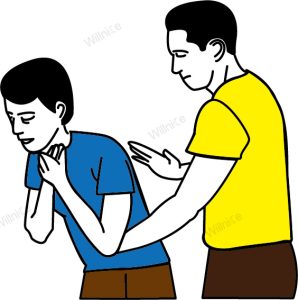
References
Related stories:
- If a choking victim is too large
- What Is a Sign of Severe Airway Obstruction?
- The Complete Guide to Choking and First Aid for Adults 2024
Final Thoughts
When faced with a choking situation, staying calm and knowing your options can save a life. If a victim is too large for the Heimlich maneuver, alternatives like chest thrusts, back blows, and high-quality CPR can ensure their safety until medical help arrives.
Becoming proficient in these techniques not only empowers you to act quickly in emergencies but also reassures those around you. Knowledge truly is the best tool for preventing and managing life-threatening situations.



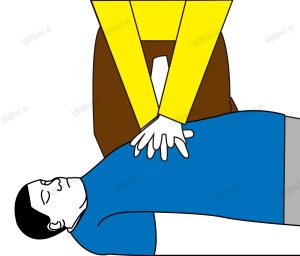

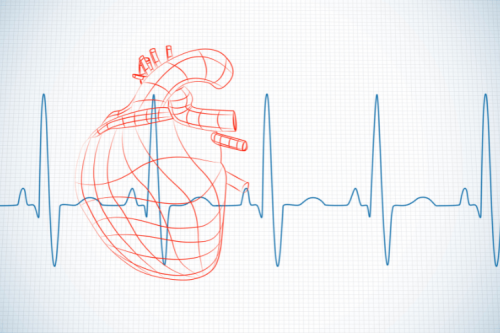


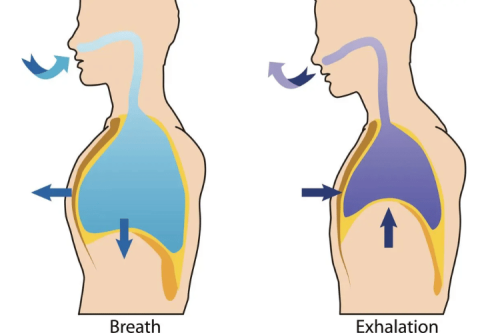
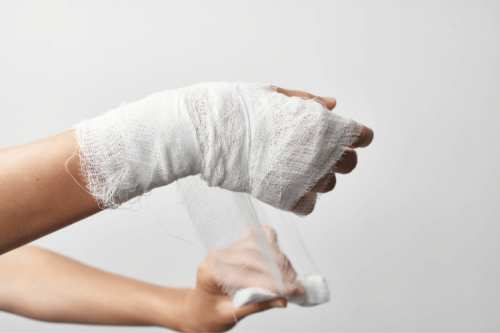
 Login with Google
Login with Google Login with Facebook
Login with Facebook